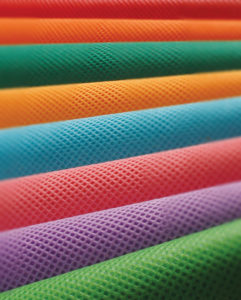
Antimicrobial properties are fast becoming a required treatment in textiles for applications that range from hospital drapes and linen to contract and domestic textiles as well as clothing. While offering protection from germs is a positive factor, there has been some disquiet concerning the environmental impact of antimicrobial treatments. In response, fiber and fabric manufacturers are working to find more sustainable solutions, and the resulting innovations are now starting to become available on the market.
Preventing Water Pollution
Water pollution is one of the primary concerns with antimicrobial treatments that rely on silver as their active ingredient. Researchers and manufacturers are looking at ways to avoid this through the production process and to find alternatives that do not compromise performance.
The Canadian manufacturer Filspec™ has developed two alternative approaches to antimicrobial treatments: Pearlite™ Rayon and RecoveryFil™. Pearlite Rayon takes its active ingredient from the insides of oyster shells that would normally go straight to the landfill. A pearl viscose offers antimicrobial properties as well as moisture absorption and a soft hand, suitable particularly for sports clothing such as socks.
RecoveryFil uses zinc oxide (ZnO) as an alternative to silver as the active ingredient, combined with a Tencel®/lyocell viscose and additional viscose embedded with fine-powdered shell from mother-of-pearl that offers protection from UV rays. The result is an antibacterial and sun protection factor (SPF) 50 fabric with a soft hand, which makes it well suited for clothing and intimate apparel.
Researchers at a group of universities headed by Linköping University in Sweden are looking to extend the use of ZnO for smart textiles. In their research and development, ZnO is grown on the surface of the textile using a simple aqueous chemical growth method. Initial results indicate strong antimicrobial properties and promising responses as a sensor.
In the Slovak Republic, Chemosvit Fibrochem a.s. has been producing fibers for 75 years and, since 1974, specializing in polypropylene under the trade name PROLEN® YARN. Yarn qualities include flame retardancy, moisture management and antibacterial properties.
The company prides itself on combining technical innovation with strong sustainable credentials. Chemosvit has been ISO 9001 certified since 1996, and has since received a number of certification standards, including OEKO-TEX® Standard 100, and has become a bluesign® system partner.
 New developments have to align with these standards, and the company’s antibacterial yarn is no exception. Prolen Bodyfresh and Prolen Siltex are both multifilament yarns that incorporate biogesic silver ions to inhibit the growth of bacteria, reducing odor and helping to maintain the skin’s freshness. The active agent is incorporated into a hollow fiber to prevent migration into waterways during the laundering process. Retaining the active ingredient longer also extends the lifespan of the product.
New developments have to align with these standards, and the company’s antibacterial yarn is no exception. Prolen Bodyfresh and Prolen Siltex are both multifilament yarns that incorporate biogesic silver ions to inhibit the growth of bacteria, reducing odor and helping to maintain the skin’s freshness. The active agent is incorporated into a hollow fiber to prevent migration into waterways during the laundering process. Retaining the active ingredient longer also extends the lifespan of the product.
A Longer Life
Extending the lifetimes of fabrics is a key strategy in creating strong environmental credentials. For most fabrics this involves wear and laundry testing, but antimicrobial materials have additional performance criteria to meet and demonstrate to be effective, particularly through wash cycles.
Longevity without compromising safety is a focus of the See It SAFE® range of reusable antibacterial woven fabrics from United Kingdom–based Toray Textiles Europe Ltd. The company uses X-Static silver fiber, where the silver is permanently bonded to the surface of the fiber for the lifetime of the woven fabric. The electron release of the silver happens when the bacteria attracts the metal that then breaks through its wall, disrupting the DNA by binding with ammonia, denaturing proteins and neutralizing odor.
Meeting environmental standards is a core concern with NILIT® Ltd., headquartered in Israel. Focusing on performance fibers, all of its polymers meet the OEKO-TEX Standard 100, demonstrating that they carry no health risk. The company’s BodyFresh fiber is designed to perform well and be kind to the environment. Antibacterial properties are combined with a soft hand to provide the wearer with freshness and comfort during workouts and sports activities. The antibacterial treatment is embedded within the microfiber to make it more resilient to wear and laundering. In testing performed by the Hohenstein Institute headquartered in Germany, the fiber was shown to retain its level of odor-reducing capability through fifty wash cycles.
When Less is More
Using less product is ultimately better for the environment, as there is less weight in shipping, fewer launderings and smaller mass for disposal at the end of useful life. Two production processes that are helping to achieve this goal are highly engineered yarns and nanotechnology.
Mightytop® II Eco and Filcare yarns from Teijin Ltd. in Japan are polyester yarns engineered to have a hollow core. Mightytop carries antibacterial and deodorizing characteristics and helps to repel dust mites. Filcare is also antibacterial, with a Y-shaped internal structure and a silicone coating. Both are used in bedding products.
One of the many benefits of nanotechnology as a coating treatment is that it reduces the amount of product needed, offering economic and environmental savings. Nanotechnology is still a relatively young technology, so standards can vary enormously. In Taiwan, the Industrial Development Bureau, Ministry of Economic Affairs has developed a nanoMark certification with the Taiwan Nanotechnology Industry Development Association (TANIDA) that’s responsible for the verification system.
Everest Textile Co. Ltd., headquartered in Taiwan, is one of the companies that has received accreditation in the production of antibacterial textiles. Its Nano Silver Yarn has undergone testing for cell and oral toxicity, skin irritation and performance after dyeing and finishing. In AATCC 100 tests involving 100 washes, the material was found to retain 99 percent of its antibacterial effectiveness. The association has a large number of standards compiled, including the TN-024 V+V specifically for nanosilver and antibacterial textiles.
New Opportunities
Dr. Vaman Kulkarni, global business development director for Americhem, headquartered in Cuyahoga Falls, Ohio, says that unless some of the inherent performance longevity and sustainability concerns around topical antimicrobial applications can be addressed, melt-spun, fiber-fused antimicrobials will continue to be the best option for textile producers moving forward.
“In the coming years, the industry can expect to see more solutions enter the market that deliver the lasting performance that comes from integration of mineral-based antimicrobial agents in the fiber production phase, while addressing the cost concerns of the marketplace through innovative chemistries,” Kulkarni says.
But environmental concerns around traditional antimicrobial processes have also forced researchers and manufacturers to seek creative solutions to the problem. What is emerging are new developments in manufacturing processes that use less material in more economical ways, paired with the introduction of novel alternatives. Problems can also foster opportunities for a forward-thinking industry.
Marie O’Mahony is an industry consultant, author and academic. She is the author of several books on advanced and smart textiles published by Thames and Hudson and a visiting professor at the Royal College of Art (RCA), London.
Antimicrobial performance is especially important in medical applications, where microbe control is crucial to maintaining a healthy environment. The global antimicrobial medical textiles market is expected to witness significant growth due to rising awareness regarding better health care practices, increasingly older populations, technological advancements and regulations promoting the use of antimicrobial textiles.
 TEXTILES.ORG
TEXTILES.ORG


